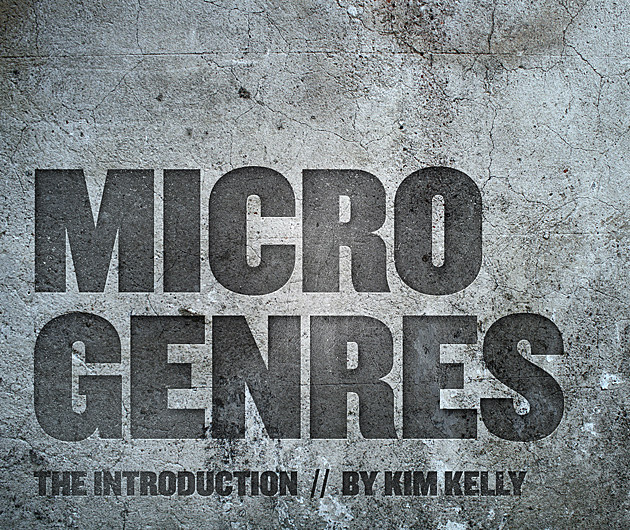
Microgenres #1 - The Introduction

Metalheads like naming things. Whether we’re talking stage names (always a little dodgy if your band was formed after 1995), area-specific entities (“Eh, I prefer the Stockholm sound – the Gothenburg bands were too soft”), or the obsessive allegiance to micro-categorization required to differentiate between almost-but-not-quite-identical subgenres (goregrind and pornogrind, for example), we as a group take great pleasure in cataloguing and defining.
In some regards, devoting oneself to metal fandom is rather like starting a baseball card collection; one is required to acquire a huge amount of knowledge about a certain type of item, much of it based on dates, affiliations, and statistics, as well as a nuclear stockpile of said physical items, and then, on top of it all, the ability to recall any shred of arcane knowledge with lightning speed. Minutiae make our world go ’round, and our nerdy tendencies are more a mark of dedication than anything negative. It takes a lot of love to memorize a particular player’s stats, just as much as committing Sarcofago’s entire discography – bootlegs included – to memory does.
Bands hate seeing their music pigeonholed, stamped with a label, and tucked neatly away alongside their peers, but we as fans and as writers just can’t tear ourselves away from our beloved little genre nametags (“Hi, my name is Black/Thrash! Not to be confused with Thrash over there, or with Black Metal glowering at you from that corner, god forbid you mix us up lest Dio himself appear and bid you with a stern point of his gnarled finger to LEAVE THE HALL!”).
Why, though? Why does it even matter? At the heart of it all, it’s still just “metal,” right? That’s easy to say, but much tougher to put into practice. It’s a lot easier on a listener if, instead of sitting down to absorb a well-written, lengthy review that thoroughly examines the various aspects of a piece of music in loving detail, one can simply glance down, read the words “tech death” or “blackened doom”, make a snap decision, then go about one’s day, right? This is precisely why bands despise being slapped with a genre label so very much – it isolates them, and gives them no chance to appeal to newcomers. It bolsters musical prejudices (“Oh, they play funeral doom? I hate that shit, they must be boring”), and crams them into a box in which they can barely draw breath. Genre labeling is lazy and aggravating, and yet we thrive upon it.
As metal continues to evolve and invert and pervert itself, traditional titles no longer cut it, and we reach for greater levels of complexity in our compartmentalization. Does the term “black metal” really do justice to a band like Deathspell Omega any more, let alone something like Oranssi Pazuzu? What about Opeth – they’re not simply a “death metal” band anymore, are they? How much do Funebrarum and At the Gates have in common, besides the ubiquitous “death metal” tag? It can get messy.
At the beginning, there was no need for any of it. There was only heavy metal – no more, no less (unless you really want to get into things like hard rock, and acid rock, and blues rock…). From there, the circle expanded, spreading out from Birmingham all the way across the globe, growing and changing with every passing year. Soon enough, we had thrash metal, death metal, black metal, traditional metal, and doom – umbrellas terms for specific sounds and scenes that crossed over and intermarried and, within a few years’ time, spawned litter upon litter of musical mutants. Doom metal has spilled over into stoner doom, death/doom, funeral doom, black/doom, progressive doom, traditional doom, gothic doom, sludge, atmospheric sludge, black/sludge, drone, post-doom… that’s a long way from “Behind the Wall of Sleep”, and that’s merely one example. Black metal in particular has gone absolutely berserk (“avant-garde black metal”? What does that even mean?), with even regression-loving death metal hot on its heels: I’ve seen the phrase NWOSDM – “New Wave of Old School Death Metal” – used. Come on now. The prevalence of hyper-labeling is almost funny at this point.
As entries in the “Genres” section of our collective iTunes keep multiplying like hungry Tribbles, bands find more and more ways to build upon metal’s grimy roots, creating scores of spectacular (or just spectacularly crappy) sounds. The once dark palette has filled with splashes of color. Heavy metal will always be the law, but its bastard children continue to spread the disease far and wide.
When all’s said and done, microgenres can be useful, if sometimes distasteful – a necessary and generally harmless sort of evil. That’s the basic premise behind this new series. For the next few months, we’ll be tackling a number of our favorite itsy-bitsy scenes and no-but-what-IS-it subgenres, which will hopefully inspire plenty of thought, discussion, and squabbling over semantics. Get ready to rage.
. . .











